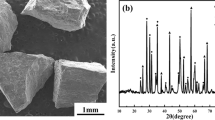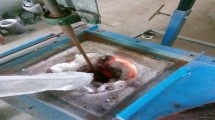Abstract
The effects of ceramic particle size and honeycomb architecture on the compressive mechanical properties and impact abrasive wear properties of ultrafine Al2O3p/high-chromium cast iron (HCCI) composites were investigated. The Al2O3p sizes are 1200 mesh and 120 mesh. The results show that the compressive strength and fracture strain of the honeycomb architecture composite (HAC) is 2021 MPa and 7.2%, which is 25.6% and 7.0% higher than those of the Al2O3p uniformly distributed composite (UDC), respectively. Therefore the composite architecture can effectively increase both the strength and toughness. Besides, the compressive strength of the UDC containing 1200 mesh Al2O3p is 10% higher than that of the 120 mesh Al2O3p reinforced UDC. Therefore, ultrafine particles can improve the compressive strength of iron matrix composites more effectively. Furthermore, the HAC possesses the highest wear resistance among all researched materials, which is 34.2% and 40.3% higher than those of the UDC and HCCI, respectively.









Similar content being viewed by others
References
W. Li, Technical Roadmap of China Casting Wear-Resistant Material Industry (Mechanical Engineering Press, China, 2013).
Y.M. Gao, Foundry 61(09), 985 (2012).
W.P. Chen, S.F. Yang, and M.Y. Han, Chin. J. Nonferrous Met. https://doi.org/10.19476/j.ysxb.1004.0609.2010.02.014 (2010).
N. Chawla and K.K. Chawla, JOM. https://doi.org/10.1007/s11837-006-0231-5 (2006).
A. Mandal, J.K. Tiwari, and B. AlMangour, Tribol. Int. https://doi.org/10.1016/j.triboint.2020.106525 (2020).
N. Kang, W.Y. Ma, and F.H. Li, Vacuum. https://doi.org/10.1016/j.vacuum.2018.04.044 (2018).
C.L. Xu, D.H. Lu, and L. Tang, Acta Mater. Compos. Sin. https://doi.org/10.13801/j.cnki.fhclxb.20200220.002 (2020).
F. Saba, F.M. Zhang, S.L. Liu, and T.F. Liu, Compos. B. https://doi.org/10.1016/j.compositesb.2018.12.014 (2019).
B. AlMangour, D. Grzesiak, and J.M. Yang, Mater. Des. https://doi.org/10.1016/j.matdes.2016.02.022 (2016).
A. Farid and S.J. Guo, Acta Mater. https://doi.org/10.1016/j.actamat.2006.10.009 (2007).
A. Mortensen and J. Llorca, Annurev-matsci. https://doi.org/10.1146/annurev-matsci-070909-104511 (2010).
H. Klaasen and J. Kübarsepp, Wear. https://doi.org/10.1016/j.wear.2005.12.004 (2006).
E. Pagounis and V.K. Lindroos, Mater. Sci. Eng. A. https://doi.org/10.1016/S0921-5093(97)00710-7 (1998).
J.E.P. Ipiña, A.A. Yawny, R. Stuke, and C.G. Oliver, Mater. Res. https://doi.org/10.1590/S1516-14392000000300005 (2000).
M. Ashby, Scr. Mater. https://doi.org/10.1016/j.scriptamat.2012.04.033 (2013).
D. Zhang, G.D. Zhang, and Z.Q. Li, Mater. China 29(04), 7 (2010).
H.X. Peng, Z. Fan, and J.R.G. Evans, J. Microsc. 201(2), 333 (2001).
D.H. Lu, G.Y. He, L.K. Wang, and C. Liao, Mater. Sci. Technol. https://doi.org/10.1080/02670836.2019.1590504 (2019).
C.Y. Jiang, D.H. Lu, W. Ma, G.Y. He, and S.A. Ahmad, Mater. Commun. https://doi.org/10.1016/j.mtcomm.2021.102623 (2021).
W.H. Gong, D.H. Lu, G.Y. He, W. Ma, and Q.H. Yan, J. Iron Steel Res. Int. https://doi.org/10.1007/s42243-021-00670-7 (2021).
M.J. Zhou, Y.B. Jiang, and F.F. Wen, Int. Mater. Rev. https://doi.org/10.11896/j.issn.1005-023X.2017.014.025 (2017).
M.J. Zhou, Y.H. Jiang, and D.H. Lu, Int. Mater. Rev. https://doi.org/10.11896/j.issn.1005-023X.2018.24.021 (2018).
H. Berns, Wear 254(1–2), 47 (2003).
W. Ma, D.H. Lu, L. Tang, W.H. Gong, and Q.H. Yan, Mater. Res. Express. https://doi.org/10.1088/2053-1591/abe019 (2021).
Acknowledgements
The authors acknowledge the financial support for this work from the National Natural Science Foundation of China (51461025) and the National Natural Science Foundation of China (51865024).
Author information
Authors and Affiliations
Corresponding author
Ethics declarations
Conflict of interest
The author declares that he has no conflict of interest.
Additional information
Publisher's Note
Springer Nature remains neutral with regard to jurisdictional claims in published maps and institutional affiliations.
Rights and permissions
About this article
Cite this article
Wang, Y., Lu, D., Ma, W. et al. Compression and Wear Properties of Ultrafine Al2O3p/Iron Composites Prepared by Cast Infiltration. JOM 74, 1878–1885 (2022). https://doi.org/10.1007/s11837-022-05237-9
Received:
Accepted:
Published:
Issue Date:
DOI: https://doi.org/10.1007/s11837-022-05237-9




